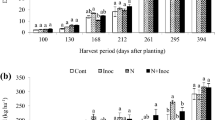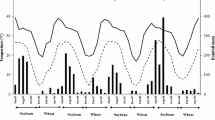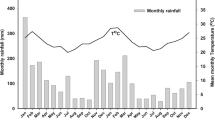Summary
A two-year field study was undertaken using15N isotope techniques to differentiate between stimulation of N uptake and N2 fixation in Western Canadian cultivars of spring wheat (Triticum aestivum L. emend Thell) and durum (T. turgidum L. emend Bowden) in response to inoculation with N2-fixing bacteria.
Bacterial inoculation either had no effect or lowered the % N derived from the fertilizer and the fertilizer use efficiency. Despite the depression of fertilizer uptake, inoculants did not alter the relative uptake from soil and fertilizer-N pools indicating that bacterial inoculation did not alter rooting patterns. Nitrogen-15 isotope dilution indicated that N2 fixation did occur.
In 1984, % plant N derived from the atmosphere (% Ndfa) due to inoculation with Bacillus C-11-25 averaged 23.9% while that withAzospirillum brasilense ATCC 29729 (Cd) averaged 15.5%. In 1985, higher soil N levels reduced these values by approximately one-half. Cultivar x inoculant interactions, while significant, were not consistent across years. However, these interactions did not affect cultivars ‘Cadet’ and ‘Rescue’. In agreement with previous results, ‘Cadet’ performed well with all inoculants in both years while ‘Rescue’ performed poorly.
Among 1984 treatments, the N increament in inoculated plants was positively correlated with % Ndfa but no such correlation existed in 1985. N2 fixation averaged over all cultivars and strains was 17.9 and 6.7 kg N fixed ha−1 in 1984 and 1985, respectively. Highest rates of N2 fixation were estimated at 52.4 kg N ha−1 for ‘Cadet’ in 1984 and 31.3 kg N ha−1 for ‘Owens’ in 1985, both inoculated with Bacillus C-11-25, an isolate from southern Alberta soils. Inoculation with either ofAzospirillum brasilense strain Cd (ATCC29729) or 245 did not result in as consistent or as high N2 fixation, suggesting that these wheats had not evolved genetic compatability with this exogenous microorganism. These agronomically significant amounts of N2 fixation occurred under optimally controlled experimental conditions in the field. It is yet to be determined if N2 fixation would occur in response to bacterial inoculation under dryland conditions commonly occurring in Western Canada.
Similar content being viewed by others
References
Avivi Y and Feldman M 1982 The response of wheat to bacteria of the genus Azospirillum. Israel J. Bot. 31, 237–245.
Baldani V L D, Baldani J I and Dobereiner J 1983 Effects of Azospirillum inoculation on root infection and nitrogen incorporation in wheat. Can. J. Microbiol. 29, 924–929.
Baldani V L D and Dobereiner J 1980 Host-plant specificity in the infection of cereals withAzospirillum spp. Soil Biol. Biochem. 12, 433–439.
Biggins D R and Postgate J R 1969 Nitrogen fixation by cultures and cell-free extracts ofMycobacterim flavum 301. J. Gen. Microbiol. 56, 181–193.
Bremner J M 1965 Total nitrogen.In Methods of Soil Analysis. Vol. 2. Ed. C A Black pp 1149–1178. American Society of Agronomy, Madison, WI.
Cahmakci M L, Evans J J and Seidler R J 1981 Characteristics of nitrogen-fixingKlebsiella oxytoca isolated from wheat roots. Plant and Soil 61, 53–63.
Döbereiner J 1977 Plant genotype effects on nitrogen fixation in grasses.In Genetic Diversity in Plants. Eds. A Muhammed, R Aksel, and R C von Borstel, pp 325–334. Plenum Press, NY.
Elliott L F, Gilmour C M, Cochran V L, Coley C and Bennett D 1979 Influence of tillage and residues on wheat root microflora and root colonization by nitrogen-fixing bacteria.In The Soil-Root Interface. Edited by J L Harley and R Scott Russell. pp. 243–258. Academic Press, London.
Fried M and Dean L A 1952 A concept concerning the measurement of available soil nutrient. Soil Science 73, 263–271.
Germida J J 1985 Population dynamics ofAzospirillum brasilense and its bacteriophage in soil.In Nitrogen Fixation with Non-Legumes. Eds. F A Skinner and P Uomala. pp 117–118. Martinus Nijhoff Pubs. Dordrecht, Holland.
Hino S and Wilson P W 1957 Nitrogen fixation by a facultative bacillus. J. Bacteriol. 75, 403–407.
Inbal E and Feldman M 1982 The response of a hormonal mutant of common wheat to bacteria of the genus Azospirillum. Israel J. Bot. 31, 257–283.
Johnson V A and Mattern P R 1977 Genetic improvement of productivity and nutritional quality of wheat. Rep. Res. Findings U.S. Agency Int. Dev. Contract No. AID/ta-C-1093.
Kapulnik Y, Kigel J, Okon Y, Nur I and Henis Y 1981 Effect of Azospirillum inoculation on some growth parameters and N-content of wheat, sorghum and panicum. Plant and Soil 61, 65–70.
Kapulnik Y, Sarig S, Nur I and Okon Y 1983 Effect of Azospirillum inoculation on yield of field-grown wheat. Can. J. Microbiol. 29, 895–899.
Kundu B S and Gaur A C 1980 Establishment of nitrogen-fixing and phosphate-solubilizing bacteria in the rhizosphere and their effect on yield and nutrient uptake of wheat crop. Plant and Soil 57, 223–230.
Larson R I and Neal J L Jr. 1978 Selective colonization of the rhizosphere of wheat by nitrogen-fixing bacteria.In Environmental Role of Nitrogen-Fixing Blue-Green Algae and Asymbiotic Bacteria. Ed. U Granhall. Vol. 26. pp 331–342. Ecol. Bull. (Stockholm).
Lethbridge G and Davidson M S 1983 Root-associated nitrogen-fixing bacteria and their role in the nitrogen nutrition of wheat estimated by15N isotope dilution. Soil Biol. Biochem. 15, 365–374.
Lethbridge G, Davidson M S and Sparling G P 1982 Critical evaluation of the acetylene reduction test for estimating the activity of nitrogen-fixing bacteria associated with the roots of wheat and barley. Soil Biol. Biochem. 14, 27–35.
Mariotti A 1983 Atmospheric nitrogen is a reliable standard for natural15N abundance measurements. Nature 303, 685–687.
Mishustin E M 1970 The importance of non-symbiotic nitrogen-fixing microorganisms in agriculture. Plant and Soil 32, 545–554.
Neal J L Jr and Larson R I 1976 Acetylene reduction by bacteria isolated from the rhizosphere of wheat. Soil Biol. Biochem 8, 151–155.
Nelson A D, Barber L E, Tjepkema J, Russell S A, Powelson R, Evans H J and Seidler R J 1976 Nitrogen fixation associated with grasses in Oregon. Can. J. Microbiol. 22, 523–530.
Neyra C A and Dobereiner J 1977 Nitrogen fixation in grasses. Adv. Argon. 29, 1–38.
Pederson W L, Chakrabarty K, Klucas R V and Vidaver A K 1978 Nitrogen fixation (acetylene reduction) associated with roots of winter wheat and sorghum in Nebraska. Appl. Environ. Microbiol. 35, 129–135.
Porter L K and O’Deen W A 1977 Apparatus for preparing nitrogen from ammonium chloride for nitrogen-15 determinations. Anal. Chem. 45, 514–516.
Rai S N and Gaur A C 1982 Nitrogen fixation byAzospirillum spp. and effect ofAzospirillum lipoferum on the yield and N-uptake of wheat crop. Plant and Soil 69, 233–238.
Rennie R J 1980 Dinitrogen-fixing bacteria: computer-assisted indentification of soil isolates. Can. J. Microbiol. 26, 1275–1283.
Rennie R J 1981 Potential use of induced mutations to improve symbioses of crop plants with N2-fixing bacteria.In Induced Mutations — a Tool in Plant Breeding. International Atomic Energy Agency, Vienna. pp. 293–321.
Rennie R J 1986 Comparison of methods of enriching a soil with15N to estimate N2 fixation by isotope dilution. Agron. J. 78, 158–163.
Rennie R J, de Freitas J R, Ruschel A P and Vose P B 198315N isotope dilution to quantify dinitrogen (N2) fixation associated with Canadian and Brazilian wheat. Can. J. Bot. 61, 1667–1671.
Rennie R J and Larson R I 1979 Dinitrogen fixation associated with disomic chromosome substitution lines of spring wheat. Can. J. Bot. 57, 2771–2775.
Rennie R J and Larson R I 1981 Dinitrogen fixation associated with disomic chromosome substitution lines of spring wheat in the phytotron and in the field.In Associative N2-Fixation. Vol. I. Eds. P B Vose and A O Ruschel. pp. 145–154. CRC Press, Inc., Boca Raton, FL.
Rennie R J, Rennie D A and Fried M 1978 Concepts of15N usage in dinitrogen fixation studies.In Isotope in Biological Dinitrogen Fixation. pp 107–133. International Atomic Energy Agency, Vienna.
Reynders L and Vlassak K 1982 Use ofAzospirillum brasilense as biofertilizer in intensive wheat cropping. Plant and Soil 66, 217–223.
Ross P J and Martin A E 1970 A rapid procedure for preparing gas samples for N-15 determination. Analyst 95, 817–822.
Steel R G C and Torrie J H 1960 Principles and Procedures of Statistics. McGraw-Hill, Toronto. 481 p.
Subba Rao N S 1980 Crop response to microbial inoculation.In Recent Advances in Biological Nitrogen Fixation. Ed. N S Subba Rao. Edward Arnold. pp 406–420. London.
Zambre M A, Konde B K and Sonar K R 1984 Effect ofAzotobacter chroococcum andAzospirillum brasilense inoculation under graded levels of nitrogen on growth and yield of wheat. Plant and Soil 79, 61–67.
Author information
Authors and Affiliations
Additional information
Contribution from Agriculture Canada Research Station, Lethbridge, Alberta, Canada.
Rights and permissions
About this article
Cite this article
Rennie, R.J., Thomas, J.B. 15N-Determined effect of inoculation with N2 fixing bacteria on nitrogen assimilation in Western Canadian wheats. Plant Soil 100, 213–223 (1987). https://doi.org/10.1007/BF02370942
Issue Date:
DOI: https://doi.org/10.1007/BF02370942




